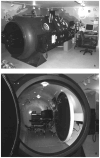Eustachian tube function in young children without a history of otitis media evaluated using a pressure chamber protocol
- PMID: 24828350
- PMCID: PMC4380175
- DOI: 10.3109/00016489.2014.882017
Eustachian tube function in young children without a history of otitis media evaluated using a pressure chamber protocol
Abstract
Conclusions: Protocol limitations were identified and accounted for in the analysis. Percent gradient equilibrated (PGE) was affected by driving gradient direction in a similar manner to other efficiency measures. A finer resolution of possible age-related changes in eustachian tube opening efficiency is expected with the application of more sophisticated statistical models to the complete dataset at study end.
Objective: To report the results of an interim analysis for an ongoing study designed to characterize the age-related changes in eustachian tube opening efficiency measured using a pressure chamber protocol in children without a history of middle ear disease.
Methods: To date, 41 children aged 3 years without a history of otitis media have been enrolled in a longitudinal study of the age-related changes in eustachian tube function and evaluated at yearly intervals between 3 and 7 years of age. Eustachian tube opening efficiency, the percent of the applied pressure gradient equilibrated by swallowing, was measured by repeat tympanometry during a pressure chamber protocol. Data (120 tests) were analyzed using an ANOVA with variance partitioned by age (3 through 6 years), gradient direction (positive/negative), and ear (left/right).
Results: PGE was higher for left ears and positive driving gradients, but was not different among age groups.
Keywords: Age effects; eustachian tube opening; gradient direction; methodology.
Conflict of interest statement
Figures


Similar articles
-
Eustachian Tube Function in 6-Year-Old Children with and without a History of Middle Ear Disease.Otolaryngol Head Neck Surg. 2016 Mar;154(3):502-7. doi: 10.1177/0194599815620149. Epub 2015 Dec 1. Otolaryngol Head Neck Surg. 2016. PMID: 26626132 Free PMC article.
-
Eustachian tube opening measured by sonotubometry is poorer in adults with a history of past middle ear disease.Int J Pediatr Otorhinolaryngol. 2014 Apr;78(4):593-8. doi: 10.1016/j.ijporl.2014.01.005. Epub 2014 Jan 13. Int J Pediatr Otorhinolaryngol. 2014. PMID: 24491807 Free PMC article. Clinical Trial.
-
Pressure chamber tests of eustachian tube function document lower efficiency in adults with colds when compared to without colds.Acta Otolaryngol. 2014 Jul;134(7):691-7. doi: 10.3109/00016489.2014.892213. Epub 2014 May 19. Acta Otolaryngol. 2014. PMID: 24834936
-
Physiology and pathophysiology of air-filled ear space and Eustachian tube function.ORL J Otorhinolaryngol Relat Spec. 1988;50(5):273-305. doi: 10.1159/000276003. ORL J Otorhinolaryngol Relat Spec. 1988. PMID: 3054692 Review.
-
Eustachian tube function tests and their diagnostic potential in normal and diseased ears.Acta Otolaryngol Suppl. 1993;500:10-3. doi: 10.3109/00016489309126169. Acta Otolaryngol Suppl. 1993. PMID: 8452005 Review.
Cited by
-
[The pressure-equalizing function of the Eustachian tube : Evaluation in a hypo-/hyperbaric pressure chamber].HNO. 2017 Aug;65(8):634-642. doi: 10.1007/s00106-016-0293-9. HNO. 2017. PMID: 27921116 Review. German.
-
Accuracy of the ETDQ-7 for Identifying Persons with Eustachian Tube Dysfunction.Otolaryngol Head Neck Surg. 2018 Jan;158(1):83-89. doi: 10.1177/0194599817731729. Epub 2017 Sep 26. Otolaryngol Head Neck Surg. 2018. PMID: 28949806 Free PMC article.
-
Immunologic dysfunction contributes to the otitis prone condition.J Infect. 2020 Jun;80(6):614-622. doi: 10.1016/j.jinf.2020.03.017. Epub 2020 Mar 20. J Infect. 2020. PMID: 32205139 Free PMC article. Review.
-
Oral pseudoephedrine decreases the rate of transmucosal nitrous oxide exchange for the middle ear.Laryngoscope. 2015 Sep;125(9):2181-6. doi: 10.1002/lary.25221. Epub 2015 Jul 7. Laryngoscope. 2015. PMID: 26152838 Free PMC article. Clinical Trial.
-
Eustachian Tube Function in 6-Year-Old Children with and without a History of Middle Ear Disease.Otolaryngol Head Neck Surg. 2016 Mar;154(3):502-7. doi: 10.1177/0194599815620149. Epub 2015 Dec 1. Otolaryngol Head Neck Surg. 2016. PMID: 26626132 Free PMC article.
References
-
- Bluestone CD, Klein JO. Otitis Media in Infant and children. 5th. Ontario: B. C. Decker, Inc.; 2007.
-
- Casselbrant ML, Villardo RJ, Mandel EM. Balance and otitis media with effusion. International journal of audiology. 2008 Sep;47(9):584–589. - PubMed
-
- Swarts JD, Bluestone CD. Eustachian tube function in older children and adults with persistent otitis media. Int J Pediatr Otorhinolaryngol. 2003 Aug;67(8):853–859. - PubMed
-
- Doyle W. Middle ear pressure regulation. In: Rosowski J, Merchant S, editors. The Function and Mechanics of Normal, Diseased and Reconstructed Middle Ears. The Hague, The Netherlands: Kugler Publications; 2000.
Publication types
MeSH terms
Grants and funding
LinkOut - more resources
Full Text Sources
Other Literature Sources
Medical
